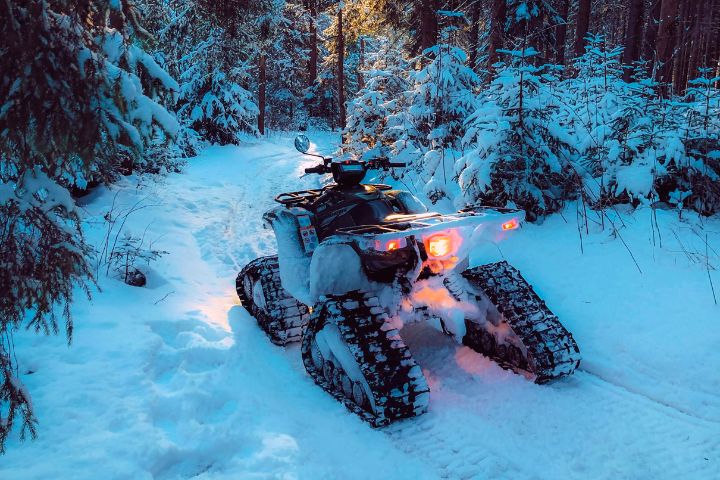Buying a used snowmobile can be an exciting venture, but it also comes with potential pitfalls. Knowing what to look for when buying a used snowmobile is crucial to ensure a wise investment and enjoyable riding experience. A thorough inspection can reveal hidden problems and save buyers from costly repairs down the line. This careful approach has an impact on both the safety and longevity of the chosen vehicle.
Prospective buyers should focus on several key areas to evaluate a used snowmobile effectively. These include examining the exterior for damage, assessing the engine and mechanical components, checking the suspension and steering, and reviewing important documentation. By paying attention to these aspects, individuals can make informed decisions and negotiate wisely. This comprehensive guide aims to provide essential insights to help buyers navigate the process of purchasing a used snowmobile with confidence.
INSPECT THE EXTERIOR FOR DAMAGE
When buying a used snowmobile, a thorough exterior inspection is crucial. This step helps identify potential issues and ensures the vehicle is in good condition. Buyers should pay close attention to several key areas during this process.
Check for dents and misalignments
A careful examination of the snowmobile's body can reveal signs of past accidents or rough handling. Buyers should look for any obvious damage, such as dents, bends, or misalignments in the body panels, hood, and bumper. It's important to ensure that everything looks square and properly aligned. Scratches from pine trees or minor wear are generally not a cause for concern, but deep cuts or significant damage should raise red flags.
Examine the skis and track
The skis and track are critical components that require close inspection. Buyers should check the skis for excessive wear, missing carbides, or signs of damage. The track should be examined for rips, tears, or missing lugs. A few torn lugs may not compromise the track's integrity, but significant damage to the track windows or grouser bars could indicate potential failure in the near future.
Look for signs of accidents
Telltale signs of past accidents can be found by inspecting specific areas of the snowmobile. Buyers should check the bulkhead for any damage, as this can be caused by hard landings or major collisions. A damaged bulkhead often requires replacement, which can be a costly repair. Additionally, inspecting the heat exchangers for stud marks or bent fins can reveal potential leaks or past impacts.
EVALUATE THE ENGINE AND MECHANICAL COMPONENTS
When buying a used snowmobile, it's crucial to evaluate the engine and mechanical components thoroughly. This step helps ensure the machine is in good working condition and can save buyers from costly repairs down the line.
Test start the engine
Before purchasing a used snowmobile, it's essential to test start the engine. This allows buyers to assess its overall condition and performance. When starting the engine, listen for any unusual noises or inconsistent revving. Let the engine run for a few minutes to make sure it's running smoothly and consistently. Pay attention to how quickly it starts and if it idles properly.
Check for leaks and unusual noises
While the engine is running, inspect for any signs of leaks or unusual noises. Look for fluid leaks around the engine, particularly oil or coolant. Low oil levels or discolored fluids can indicate poor maintenance or potential issues. Listen carefully for any knocking, rattling, or other strange sounds that might suggest internal engine problems.
Inspect belts and clutches
Examining the belts and clutches is another crucial aspect of evaluating a used snowmobile. Check the condition of the drive belt, looking for signs of wear, cracks, or missing chunks. Inspect the clutches for damage, paying close attention to areas of wear and deep grooves. A well-maintained snowmobile should have clean and smooth clutch plates, with only minor black marks being normal.
By carefully evaluating these components, buyers can make a more informed decision when purchasing a used snowmobile. This thorough inspection helps identify potential issues and ensures a better investment in a reliable machine.
ASSESS THE SUSPENSION AND STEERING
When buying a used snowmobile, it's crucial to assess the suspension and steering components thoroughly. These systems play a vital role in the machine's performance and safety.
Examine shocks and springs
Buyers should carefully inspect the shocks and springs for signs of wear or damage. Look for any leaks around the shock shafts, which could indicate worn seals. Check the rebound of the shocks by sitting on the snowmobile and then getting off. The suspension should spring back up quickly. If there's excessive sag or slow rebound, it might suggest worn-out shocks or springs.
Check for play in steering components
Steering components require close attention when evaluating a used snowmobile. Test for any play in the handlebars by gently moving them side to side and up and down. Some play is normal, but excessive movement could indicate worn bearings or other steering issues. Inspect the tie rod ends and ball joints for any signs of wear or looseness. These parts are crucial for maintaining proper steering control.
Test ride if possible
If conditions allow, a test ride is the best way to assess the suspension and steering. Pay attention to how the snowmobile handles bumps and turns. Listen for any unusual noises coming from the suspension or steering components. If a test ride isn't possible, try to lift the back of the snowmobile and give it a few light revs to ensure the track spins freely. This can help identify any issues with the suspension or track alignment.
REVIEW DOCUMENTATION AND NEGOTIATE WISELY
When buying a used snowmobile, it's crucial to review all relevant documentation and negotiate wisely. This step helps ensure a smooth transaction and protects the buyer's interests.
Check service records
Service records provide valuable insights into the snowmobile's maintenance history and reliability. Buyers should request repair invoices and maintenance records from the seller. A well-maintained snowmobile is more likely to perform well and last longer, making it a better investment. If the seller claims the engine has been reconditioned, ask for tangible proof. For newer models, note the serial number and inquire with a dealer about any applied or pending service bulletins.
Verify ownership
To avoid potential legal issues, it's essential to verify the snowmobile's ownership. Ask the seller to provide registration documents or a receipt if necessary. Check the vehicle identification number (VIN) on the title against the one stamped on the snowmobile's chassis to ensure they match. This step helps prevent purchasing a stolen or illegally modified snowmobile.
Factor in potential repair costs
When negotiating the price of a used snowmobile, consider potential repair costs. Used snowmobile owners typically spend around $800 per year on repairs, depending on the machine's condition. If a thorough inspection reveals issues, use this information to negotiate a fair price. Remember that putting $1,000 to $2,000 into repairs and maintenance adds exactly $0 to the used value. By factoring in these potential costs, buyers can make a more informed decision and negotiate a price that reflects the snowmobile's true condition and value.
CONCLUSION
Buying a used snowmobile requires careful consideration and thorough inspection. By examining the exterior, evaluating the engine and mechanical components, assessing the suspension and steering, and reviewing important documentation, buyers can make informed decisions. This comprehensive approach has a significant impact on ensuring a wise investment and a safe, enjoyable riding experience.
To wrap up, the key to a successful used snowmobile purchase lies in attention to detail and proper preparation. By following the guidelines outlined in this article, buyers can confidently navigate the process, avoid potential pitfalls, and find a reliable machine that meets their needs. Remember, taking the time to inspect and evaluate thoroughly can save both money and headaches down the road.
FREQUENTLY ASKED QUESTIONS
1. What is considered high, medium, and low mileage for a used snowmobile?
Generally, a snowmobile with over 8,000 miles is deemed to have high mileage. Those with 4,000 to 8,000 miles are categorized as medium mileage, while models with less than 3,000 miles are seen as having low mileage.
2. What should I check when buying an older snowmobile?
When inspecting an older snowmobile, it's crucial to move the handlebar from side to side to ensure it doesn't snag or offer too much resistance, as these could indicate past crashes. Additionally, inspect the cables, brakes, and general condition of all parts. Make sure to test the dials once the snowmobile is started.
3. What are key inspection points when buying a used 4-stroke snowmobile?
For a used 4-stroke snowmobile, conduct a thorough mechanical inspection including checking for crankshaft play and performing compression tests to detect low compression levels. Visually inspect the pulleys, belts, coolant levels, and under the hood. Check the front steering and suspension, rear suspension, track, slides, wheels, chassis, and radiators (for liquid-cooled models).
4. Which snowmobile model is renowned for its reliability?
The Polaris Indy SP is often celebrated as the most reliable snowmobile ever made. Known for its dependability and strong customer support, this model excels in various terrains due to its ergonomic design. It offers both speed and power, along with a smooth and comfortable riding experience.
References















